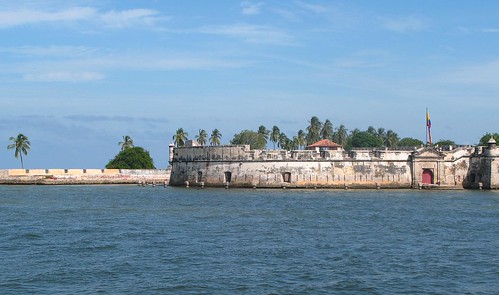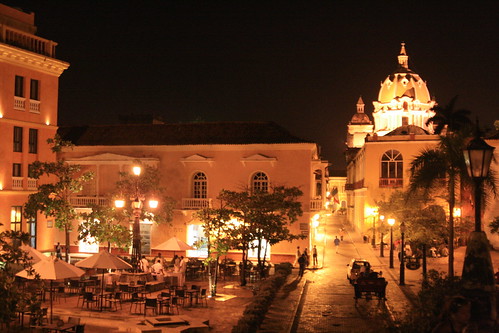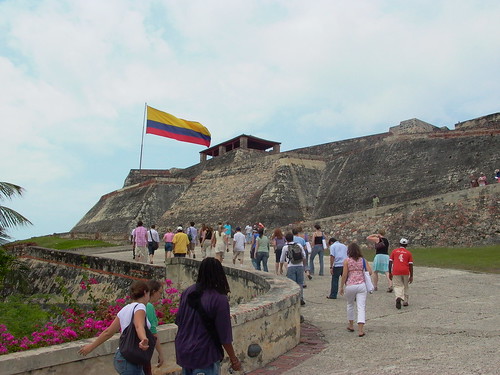The layout of Cartagena escapes a little to the Renaissance conception of straight streets that did have their contemporary sisters like Havana and Panama City. Alleys abound then not quite regular, of which apples are asymmetric and unresolved cross streets at right angles. This irregularity adds charm to a city with buildings and houses amalgam American colonial styles, Baroque, Renaissance, neoclassical and Moorish Andalusia.

Photography by Ben Bowes
Originally, the street names all correspond to saints and virgins, as indicated in each corner with signs of clay that were later replaced by plates of polished marble with floral letters that last until today. The funny thing is that the name of each street was changed several times over the centuries, as the events occurred. And those changes can be traced some of the most fascinating stories from around the colonial Caribbean.
Angels and Demons:
The current Calle de las Damas is called Our Lady of the Angels until the third decade of the seventeenth century, when they finished up the walls of Cartagena. According to Raul Porto del Portillo, author of Squares and streets of Cartagena de Indias, hearing the king of the big check he had to pay for the work of walling off the city, took a telescope to see if a work so face could be seen from across the ocean. As he did not see Charles VI apparently decided to personally assess the seven-mile wall of embarking incognito with some colleagues, all dressed woman. In his journey, the monarch lived in a house in the street Our Lady of the Angels. And around this fact wove all sorts of conjecture, just as he claimed that those ladies who had appeared encopetadas in mysterious ways, to return shortly to Spain, were nothing less than the king and courtiers. Since then, Our Lady of the Angels became the Calle de las Damas.
The history of the Street of Bitterness dating back to June 17, 1626, at the time the second «leap of faith» prepared with great pomp by the court of the Inquisition. One of those convicted of heresy was Mancera Pedro Sanchez (Fra Ambrosio), which led to the stage where the sentences were read said to a companion: «Dude, little remains to reach the place of torment just walk the little street we need to is that over time should be called Path of Bitterness. »
Of the three streets baptized there in Santo Domingo Cartagena, one of those houses is a legend in his time everyone took to the letter. Right there stands the neo-classical facade of the Santo Domingo Convent, and that just opened the devil began appearing to them on the street the faithful went to church. But according to the chronicles of the time, people became accustomed to seeing the devil and left to fear. Irritated, one day the man tail and horns of rock filled the streets to block the passage. And above the din of the crowd, the priest left the church break open a magic phrase: «Lucifer, God you can not.» At the same time, a wave rolled the rocks miserably. The miracle was followed by a plaintive laugh and a breezy flutter leaving the air impregnated with the smell of sulfur.

Photography by Carlos Adampol
The real life events that occurred there in 1621 are almost as incredible as the vicissitudes of poor Mary Servant of all the Angels, because God caused the withdrawal of the city. It all started by a seemingly minor dispute which pitted the cloistered Poor Clares the Franciscan Friars of Cartagena, who depended administratively. The Santa Clara professed complained to the bishop and Piédrola Benavides for the mistreatment and the failed economic leadership they received from their tutors Franciscans. The bishop supported, while the followers of San Francisco sided with the Jesuits and the governor. The Poor Clares, considered independently, took refuge in their convent and the Franciscan side tried to invade, along with carpenters and blacksmiths to open the huge wooden doors. At such conflict, the bishop declared a divinis cessatio, ie was suspended until further notice all religious activity in Cartagena. Somehow, this meant that God would be out of town until you calm the waters, yet increasingly agitated. The Franciscans, enraged, attacked the convent of Poor Clares fought like lions. Forewarned, the nuns prepared a thick broth boiling and when the invaders came, the sisters were ready for anything in the high windows, shower in hand. When they ran out of «ammunition», threw stones and even the contents of their toilets. Neighbors, meanwhile, gave strong support to shot muskets from the terraces. The fighting lasted about an hour and it was impossible to invade the convent, the Franciscans fled in retreat.
Hilly streets:
The name on the poster illustrating the history of ceramics of this street with the strength of a newspaper headline: Tumbamuertos. Originally it had a more pleasant, Our Lady del Popolo, because according to legend colonial house on that street lived Margoli Pietro, an Italian glad that he spent every night of wine and went to balcony to harangue the popolo. Turned to the current name in mid-1876 when a terrible epidemic of influenza swept through entire families, leaving empty houses without heirs. La Calle del Popolo was then in poor condition, and apparently several of the funeral procession passed by heading to the cemetery faced with potholes and ended with the drawer on the floor. Thereafter, in the neighborhood began to mention it as «the street where the dead lie down.» And there were those who discovered a spirit of fun enjoyed seeing the dead sprawled on the floor down.
Meanwhile, Pump Street has generated much discussion among historians Cartagena, since in this case there are no reliable documents to explain the name. The logical assumption that there once dropped a bomb has detractors who wonder «what not dropped Cartagena street once a bomb?». And this question is more logical to hypothesize that generates, because between 1544 and 1885 the city suffered eight long sites, some wins and failures. The most famous sieges of the English admiral was Sir Edward Vernon, who in 1741 arrived with the intention to seize the Spanish city with an army of 23 000 soldiers stuck on 186 boats. Among the invaders was Lawrence Washington, brother of the future American hero, while the side of the defenders had only 3 000 men. The English took them 16 days of fighting to take the Castle Bocachica. But they were defeated in the attempt to invade the Castle of San Felipe, while dysentery began to wreak havoc in their ranks, forcing them to retreat.

Photography by thefuturistics
Thus, only during the siege of Sir Vernon must have thrown bombs on each of the streets of Cartagena. So it is more accepted hypothesis that the early seventeenth century there were in the street known as a powder keg powder magazine, which was later moved to the Castle Grande pose a serious threat to the population.
In the district of San Diego there is a haunted house that belonged to a man whose name today named Calle de Quero. The story goes that Miguel Quero had inherited a fortune in gold coins, which jealously guarded and greed in a huge iron chest. One night, believing noises in the room where he kept his treasure, Don Quero lit a lamp and went to see what happened. He found nothing unusual, but could not avoid getting to count his wealth, and with such bad luck, while his head was in the casket lid fell on him, killing him with a sharp movement in the neck. The neighbors, who missed Mr. Quero, suspected the worst when a foul smell started coming out of the house. Since then the uninhabited home took a bad name and there was no one dared to come around after sundown. Until one night a brave decided to show everyone that fears were the result of fantasy, and faced toward the house from the corner of Parque Fernández de Madrid. But before he lit a cigarette, and came before the house fire a man asked from the balcony. Before she could react, a long bony hand extended from the top and snatched the cigar from one brave blow that made him pass out from fright. Another one will dare to haunted house was a homeless Antioquia requested authorization to go to live there despite the «dangers». Before moving a gun was made as a precaution and the first night he slept in the place he lay down and began to hear noises from the dining room. The man confronted the mystery gun in hand. Across the front door, a shadow passed him, he fired six shots without knowing who. But a deep voice said, throwing bullets on the floor: «I do not hurt your bullets, then you return them.» Needless to say that the brave peasant went flying down the stairs, never to return, losing it for the rest of his days.
So that over the centuries, the buildings across the colonial Cartagena are changing in appearance, but the phenomenon has no counterpart in the streets. At most of the land passed to the pavement: from one century to another name only mutates them, as they accumulate stories whose account is changed, too, from generation to generation
So we ended up with a tour full of history and legends of this mythical city of Cartagena!
Leave a Reply
You must be logged in to post a comment.
Recent Comments